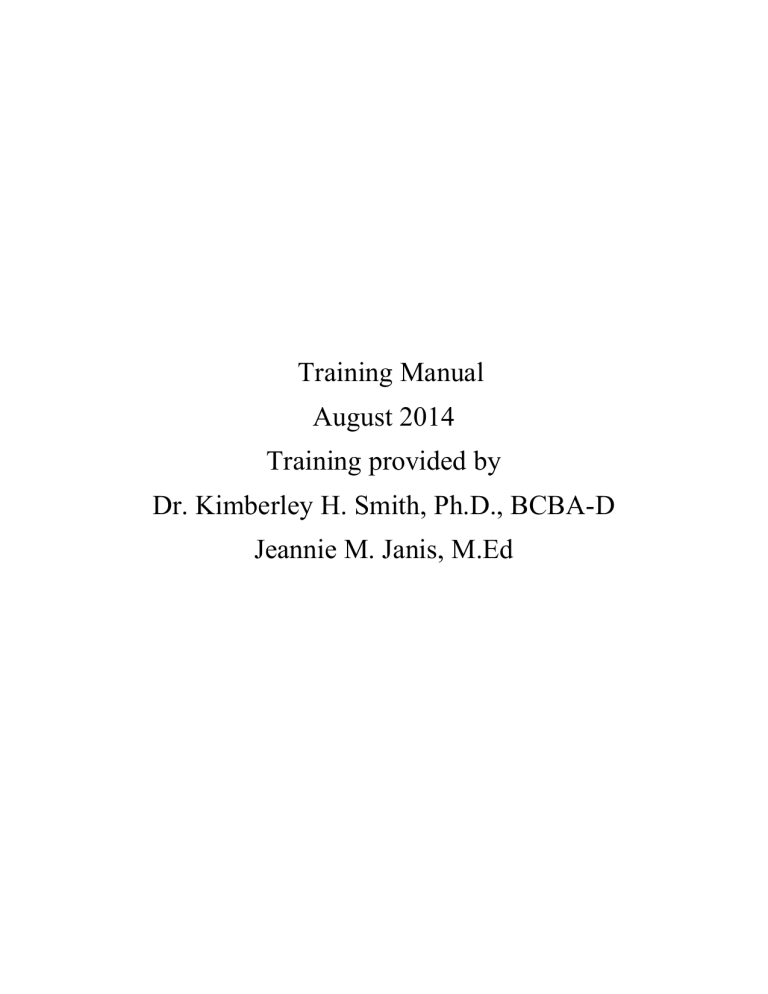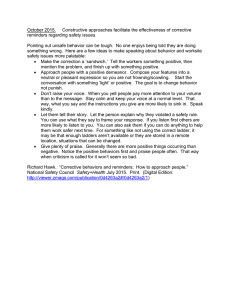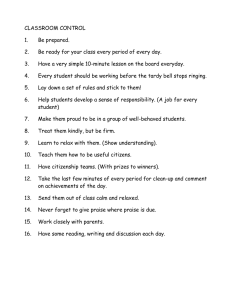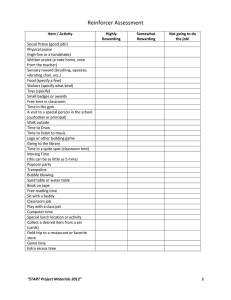
Training Manual August 2014 Training provided by Dr. Kimberley H. Smith, Ph.D., BCBA-D Jeannie M. Janis, M.Ed Overview of Staff Training Process . Training for each procedure or child specific program will involve: Written instructions: You will receive a copy of the program/procedure with the prompting/teaching steps, error correction, reinforcement and data collection procedures clearly defined. You will also receive a copy of the training checklist that will be used to give you constructive performance feedback. Verbal review: Trainers will explain the program and allow time for questions to be asked. Instructor or Video modeling: The trainer will role-play or show a video model demonstrating the procedure and he/she will also review/describe/point out key features of the program as it is modeled. Practice role-playing with the trainer acting as the child (in at least 2 different situations or with 2 different behaviors) and trainer giving performance feedback via checklists, Follow-up checklists in the actual classroom setting with the specific child the program are designed for or with the entire classroom for general center procedures. Checklists are objective ways to assess staff performance of procedures and involve answering questions about each step of the procedure with Yes, No, or N/A. Initial checklists in the classroom setting will occur during the week following the staff meeting in which the procedure was trained. Checklists will occur on a regular basis until mastery criteria are met and then checklists will be done intermittently to ensure maintenance of the skill. In order to reach mastery of a procedure, you MUST correctly implement the procedure in the actual classroom setting THREE CONSECUTIVE times at 100% correct. Feedback is an essential component to staff training. The more feedback you receive, the more you will succeed at a very difficult task so please don’t hesitate to ask for additional support. I will give it with a smile. 2 Rules to Live By 1. Be persistent and consistent. Most kids love to test the limits with people. You must show them that their inappropriate behavior will not get a reaction from you. This will cause them to try harder in the beginning of a new procedure to get your reaction. You need to try your best to execute all of the general program procedures and the child’s programs as you are trained. By doing this you will establish yourself as someone that the kids will have fun with, but also as someone who enforces the rules and isn’t deterred by undesirable behaviors (such as tantrums, aggression, threats, etc.) By giving attention in the moment to these behaviors, you are giving the child what they desire. 2. Your data sheet is your new best friend. Record each hour how many tokens you award to him/her. 3. Behavior Programs both skill acquisition and behavior reduction programs are written so that each person that works with the child is doing the EXACT same thing. Being very business like with him/her, except when awarding tokens or praise is critical to the success of the BIP. The details are VERY important, and knowing the gist of a program is just not enough. 4. If you don’t know ASK. . . don’t assume you’re right, or do it your own way and ask later. Building on Rule #2, consistency is key and when behaviors are intermittently reinforced (i.e.: they “work” sometimes but not others) they are very hard to “undo”. 3 GIVING DIRECTIONS TO KIDS Purpose: Teachers are often frustrated when they feel like the kids in their class aren’t listening to their directions or requests. In order to help kids follow our directions more easily, we need to figure out why the kids aren’t complying. By changing the way we give directions, we can help kids learn to follow them. Possible reasons why directions may not be followed: There are a number of reasons why kids may not be doing what you ask them to do. The child may not understand the direction you are giving them. It may be too complicated. For example: “put the toys away, the books on the shelf, and come line up” It may imply choice. For example: “Can you try going potty now?” “Can you pick up your toys for me?” It may be given too far in advance of when it’s expected to be completed. For example: “After snack I want you to get a book and read it on the carpet.” It may be too vague, or stated in terms that are difficult for the child to understand. For example: “I need you to straighten up the books on the bookshelf” You may not have the child’s full attention when you give the direction. The child may be occupied with a toy or activity and not attend to your voice. The direction may be given from too far away. i.e.: across the room, etc. The child may not be motivated to follow your directions. They may have learned that fussing, tantrums, or ignoring you lets them get out of following a direction. Guidelines for Giving Directions Effectively: Give one direction at a time and keep directions short and simple. Make sure your directions do not imply that following them is a choice the child can make. Give directions as FIRM STATEMENTS rather than QUESTIONS. When you say things like “will you clean up for me?” the child has the option of saying “no”. So instead you should say “You need to put the book away now.” Be specific about what you want the child to do. I.e.: Say, “Put the blocks in the bucket” rather than saying, “Clean up”. Make sure you have the child’s attention. You may need to interrupt their play by standing in front of them or controlling access to what they are playing with. Being within arms reach and at their eye level increases chances of the child attending. State the direction in positive terms. Tell the child what to do rather than pointing out what they should not be doing. The direction “Don’t run!” only tells kids what not to do, but the direction “let’s use walking feet when we’re inside” teaches them what they should do. 4 Least-to-Most Prompting Procedure For use during any situation where she is not complying with adult directions. • Purpose: Tell, Show, Remind is a Least-to-most prompting procedure that is used to promote independence in self-care, acquisition programming and compliance with adult instructions. • Description/Steps: • General Education: Give general directions to the class. 1. WAIT or Latency prompt-for an appropriate response. (1-2 minutes) 2. TELL or Say- “You need to ____________” or other verbal prompt. (Wait a few seconds for an appropriate response) Make sure that it’s a simple and specific statement. 3. SHOW or Gesture- Give a visual cue, point to, or model what they need to do (wait a few seconds for an appropriate response) 4. Remind of consequence: Remember, you are earning points for ________. If ______ complies at any point, give behavior specific praise. Give more “excited” praise for compliance at the Wait level of compliance and less “excited” if the Remind step is needed. If ______ engages in problematic behavior at any time, continue with the procedure steps and use Attend and Ignore. **Do not engage in any other talking with him/her during the procedure. 5. Full Physical Prompt- Physically guide him/her through the task until completion. If ______ engages in problematic behavior at any time, continue with the procedure steps and use Attend and Ignore. **Do not engage in any other talking with him/her during the procedure. • Important Tips 1) Do NOT start using this procedure unless you are ABSOLUTELY CERTAIN that you can follow through with all of the steps. If you continually start using it, and then don’t follow through, the procedure loses its validity as a tool for promoting independence and ______ will quickly learn that your words don’t mean much (ie: that he doesn’t have to respond to you). 2) The amount of time that you wait between steps should be around 10-15 seconds. 3) Behavior specific praise should follow compliance at any step. 5 3-Step Guided Compliance: Tell, Show, Do Least-to-Most Prompting Procedure Checklist Person Observed: ________________________________ Please mark each column Y, N, or N/A and make comments as necessary. Date: Time Observed: Observer: Direction/Activity: During the 5 minute observation did the person being observed do the following? 1. Provide direction to an individual child or group. (TELL) 2. Wait 3-5 seconds. 3. Provide enthusiastic and behavior specific praise for compliance. 4. Provide direction to an individual child or group. (TELL) 5. Wait 3-5 seconds. Praise if correct response given. 6. Model or gesture the desired behavior. (SHOW) 7. Wait 3-5 seconds. Praise if correct response given. 8. If no response remind him/her of the goal on the token board. (TELL) 9. Wait 3-5 seconds. Praise if correct response given. 10. Provide physical guidance to have child complete task. (DO) 11. Provide a neutral confirmation once the task is completed. 12. Repeat procedure for all steps of the task. (if necessary). If problems occur with this prompting procedure, consult the case manager. Percentage Correct Feedback given (trainee initials) 6 Attend and Ignore Purpose: All children are likely to engage in undesirable behaviors for peer or teacher attention/reaction. Thus, it is important to have a consistent plan in place to deal with these behaviors when they occur, which will help to minimize reinforcement provided for inappropriate behaviors. In most cases, the following steps should be employed to prevent and respond to these undesirable behaviors. Description/Steps: Attend and Ignore is a procedure that attempts to prevent problem behaviors by ensuring high levels of engagement (active involvement in an activity) and positive teacher attention (behavior specific praise, interactive play, incidental teaching episodes, etc.). You should provide praise and attention to appropriately engaged children at least one time per five minutes. When problem behaviors occur in spite of prevention efforts, Attend and Ignore involves not directly attending to the problem behavior (i.e.: ignoring it unless potentially harmful), praising other children who are behaving appropriately (if applicable) or modeling appropriate play, etc. and ONLY attending to the child when his/her undesirable behavior stops. For specific steps involved in the procedure see the checklist below. Setting: Any location throughout the school where problem behaviors are occurring. Occasions for use: Any time problem behaviors that will not cause harm to self, others or property. Problem behaviors that may be addressed with Attend and Ignore include: yelling, screaming, annoying noises (tapping fingers, stomping feet under the table, etc.) whining, tattling, leaving seat, etc. In situations where the child is likely to injure themselves or another child, staff should always intervene to prevent injury and ensure safety while providing minimal attention. 7 Attend and Ignore Checklist Person Observed: ___________________________________ Please mark each column Y, N, or N/A and make comments as necessary. Date: Time Observed: Observer: Activity: During the 5 minute observation did the person being observed do the following? 1. Praised and gave attention to children behaving appropriately 1x per 3-4 minutes minute (5x’s during observation period) Tally in box Undesirable Behavior that Occurred (list) 2. Did not attend to the behavior (e.g., did not talk about behavior, averted eye gaze, no smiling, no laughing, had neutral facial expression) 3. Interrupted behaviors that are potentially harmful to child, others or property with no verbal/nonverbal reaction. 4. Immediately delivered behavior specific praise and points when child engaging in undesirable behavior engaged in appropriate behavior. 5. If inappropriate behaviors began again while praising/attending, Attend-Ignore was re-implemented immediately. y n n/a y n n/a y n n/a y n n/a y n n/a *NOTE: If the undesirable behavior continues after this procedure is implemented, contact the child’s case manager. Percentage Correct Feedback received (trainee initials) 8 Delivering Social Praise/Reinforcement Purpose: Students often engage in undesirable behaviors that attract a lot of attention. By using verbal praise and attention frequently throughout the day, students are receiving a lot of attention for positive behaviors and less attention for negative behaviors. Why do we use social praise? We use praise to reinforce behaviors we want to see more often We use social praise frequently because it is free and always available. Other forms of reinforcement may include a punch card or other items to which the student wants to gain access. You must praise specific behaviors. Sometimes it’s difficult to find something good the student is doing but try!! It may take a minute but they will do something good eventually. When they do PRAISE IT!! Don’t be tempted to redirect inappropriate behaviors! Remember to use your attend and ignore skills. Like we said, it may take a minute but something good will happen. No matter how small it is find it and praise it. Deliver the praise RIGHT AWAY. It needs to happen as quickly after the behavior is observed as possible. Wait too long and you may reinforce something you don’t want to happen again. Make sure to praise the presence of a desirable behavior not the absence of an undesirable behavior. You can only praise something they actually do not something they didn’t do. Four types of social praise. 1. Individual call-out : call the person out by name. i.e “George! Thanks for picking up that trash on your way out.” 2. Group call-out : Use any characteristic to define a group of students. i.e “everyone on the left side of the class”. 3. Pivot : Use one student’s attending behavior to prompt another student to do the same 4. Quiet: Something that is just between you and the individual. i.e thumbs up, pat on the back, smile, etc. 9 Guidelines for Delivering Verbal Praise: Make sure to be specific. i.e: say “I love the way you are working that math problem out.” Instead of “good work”. Make sure to praise good things the student is doing not something they are not doing. I.e.: Say, “Thanks for using nice words with the teacher” instead of saying “thanks for not cussing.” Deliver praise in a happy voice and with a smile and eye contact. Smile and make eye contact while using an enthusiastic voice. It can be done quietly so as not to bother other students. Use one of the four types of verbal praise 10 Delivering Social Praise/Reinforcement Person Observed: ___________________________________ Please mark each column Y, N, or N/A and make comments as necessary. Date: Time Observed: Observer: Activity: During the 5 minute observation did the person being observed do the following? 1. Delivered verbal praise at least one time every two minutes during the observation period 2. Praise was specific 3. Praised positive things the student did, instead of commenting on things the student did not do 4. Used a happy voice, made eye contact, and smiled 5. Used one of the four types of verbal praise Percentage Correct Feedback received (trainee initials) 11 Awarding Tokens Purpose: To ensure that he/she receives positive reinforcement throughout the day at intervals necessary to prevent and decrease the likelihood that he/she will engage in maladaptive behavior to get attention. Why do we use a token system? This system could be implemented using points, tokens, coins, or hole punches. The token system is convenient for him/her because they can easily see how many more responses have to be made to contact reinforcement, and it is easily replaceable if they destroy it, and it is easily transported from classroom to classroom. Special Education Teacher Role: __________ will be responsible for conducting a preference assessment when he/she arrives at school, and again mid-morning, and midafternoon. All Teachers: Every 5 minutes if he/she has followed directions, remained on task, and used appropriate language; he/she gets a token delivered. (may be silent affirmation if classroom environment must be quiet) If he/she meets the criteria determined as their goal, they can cash in the tokens for the reinforcer they selects. All staff: Make sure to take time to let the student know you are proud of them for earning their tokens at least once or twice a week. 12 Awarding Hole Punches/Points/Tokens Person Observed: ___________________________________ Please mark each column Y, N, or N/A and make comments as necessary. Date: Time Observed: Observer: Activity: During the 5 minute observation did the person being observed do the following? 1. Staff conducts preference assessment when student arrives at school and mid-day. (more if needed) 2. Staff awards tokens for observation of appropriate behaviors listed in BIP. 3. Staff provides verbal or non-verbal affirmation of compliance with the rules. 4. Teacher provides last token if all tokens rewarded during class. Use verbal praise when delivering them. Percentage Correct Feedback received (trainee initials) 13 Notes: 14




